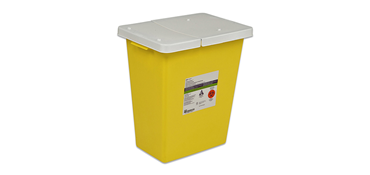Handling Antineoplastic or Investigational New Drugs
See procedures for UC San Diego researchers working with antineoplastic drugs or investigational new drugs.
Antineoplastic are defined as medications used to treat cancer. Antineoplastic drugs are also called anticancer, chemotherapy, chemo, cytotoxic, or hazardous drugs. To determine if a drug is classified as hazardous please check the NIOSH List of Antineoplastic and Other Hazardous Drugs in Healthcare Settings (2016) the list is not all-inclusive.
Appropriate chemical handling, administration, personal protective equipment, and waste disposal techniques are crucial for the safe handling of these chemicals. Please refer to NIOSH - Preventing Occupational Exposures to Antineoplastic and Other Hazardous Drugs in Health Care Settings to assist in completing training guidelines.
Training guidelines
Principal investigators (PI) or a knowledgeable designee must provide appropriate safety training.
- Inform employees about handling the drug or chemical, its physical properties (including solubility), and health effects seen in experimental studies and other applicable sources.
- Review toxicological data from similar compounds if toxicological information is limited.
- Explain possible routes of exposure as appropriate:
- Inhalation
- Skin absorption
- Accidental injection
- Provide and train employees in the proper use of personal protective equipment and engineering controls to prevent exposure.
Animal subjects
Personal protective equipment requirements
- Wear safety glasses.
- Protect your hands and forearms by wearing non-powdered gloves and a lab coat to avoid skin contact. Do not expose skin between your gloves and forearms.
- Wash your hands and arms immediately after working with the substance.
Respiratory hazards
Use appropriate containment if aerosols may be created during the work, or if the substance is volatile.
- Perform the work inside a chemical fume hood or other suitable containment device, such as a glove box.
- If vapors will be released from the apparatus, attach a trap, filter, or condenser as appropriate.
Spills and exposures mitigation
- Restrict access to the work area.
- Keep container sizes and quantities in the work area as small as possible.
- Line work surfaces with removable plastic-backed absorbant paper.
- Double-contain the substance in chemical-resistant trays. Contain lab instruments within pans or trays to contain spills.
Waste management
Trace-chemo waste

Trace-chemo waste is considered contaminated through contact with, or having previously contained, chemotherapeutic agents, including but not limited to empty syringes, containers, gloves, gowns, towels, vials, and intravenous solution bags and attached tubing that are empty. Trace chemo wastes are required to be incinerated per the CA-Medical Waste Management Act (MWMA).
Trace chemo waste sharps must be collected in a designated yellow waste container. Trace chemo waste sharps include the following:
- Sharps with trace chemo/antineoplastic drugs
- Sharps with trace chemo/antineoplastic and biohazards
- Empty trace chemo/antineoplastic vials
Non-trace chemo waste
Non-trace chemotherapy waste is considered a hazardous waste and must be disposed of through EH&S using the Online Waste Tag Program (OTP) eg., unused expired chemo/antineoplastic drugs, containers with pourable amounts of liquids, materials used to clean up large spills of antineoplastic drugs.
Empty containers of the following specific chemotherapeutic/hazardous drugs must also be disposed of using the OTP.
|
Waste Code |
Constituent of Concern |
Product Name Examples |
|
P001 |
Warfarin and salts (>0.3%) |
Coumadin, Warfarin |
|
P012 |
Arsenic trioxide |
Trisenox |
|
P042 |
Epinephrine |
Adrenaline, EpiPen, Eppy/N, Epifrin, Epinal, Anaphylaxis kit, Epinephrine, Racepinephrine, Racord, Primatene inhaler |
|
P046 |
Phentermine |
Phentermine (CIV) |
|
P075 |
Nicotine and salts |
Nicotine patches, Habitrol, Nicoderm, Nicorette, Nicotrol, Tetrahydronicotyrine |
|
P188 |
Physostigmine salicylate |
Eserine salicylate |
|
P204 |
Physostigmine |
Eserine |
Frequently asked questions (FAQ)
Are solutions containing a trace amount of a chemotherapeutic or hazardous drug considered trace chemotherapy waste?
No, these solutions would be considered non-trace waste and must be managed as hazardous waste by EH&S. Trace chemotherapy waste does not include liquids. Trace chemotherapy waste includes empty containers, syringes, IV bags, vials, and incidentally contaminated ppe, etc…
Is animal bedding contaminated with trace amounts of antineoplastic drugs considered hazardous?
Yes, please refer to the waste guidance described in Animal Experiments Using Antineoplastic or Investigational New Drugs.